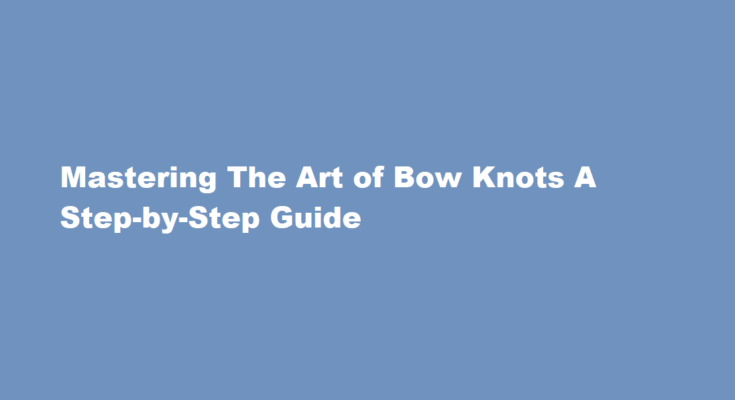Introduction
The art of knotting a perfect bow is a skill that can elevate your fashion sense, add a touch of elegance to your gifts, and even enhance your crafting projects. Whether you’re tying a bow tie, wrapping a gift, or embellishing a DIY project, knowing how to create the ideal bow knot is a valuable skill. In this article, we will guide you through the process step by step, ensuring that your bows always come out beautifully.
Choose the Right Material
Before diving into the knotting process, it’s essential to select the appropriate material for your bow. Whether it’s a ribbon, fabric, or any other suitable material, ensure that it is of high quality and well-suited for your specific purpose. The material’s texture, color, and width should align with your project or outfit.
Determine Bow Size
The size of your bow should complement the item or outfit you’re working with. For instance, smaller bows work well for delicate accessories like hairpins or necklaces, while larger bows can be perfect for gift wrapping or decorating home crafts. Measure and cut your material accordingly, leaving extra length to work with.
Create the Two Loops
Fold your chosen material in half, forming a simple loop on one side with two loose ends. This loop will become one side of your bow. The length of the loose ends will determine the size of your bow’s loops, so make sure they are even in length for a symmetrical appearance.
Cross the Loops
With one loop formed, take the second loose end and cross it over the first loop, creating an “X” shape in the middle. Hold the intersection point securely between your thumb and forefinger to maintain control over the loops.
Wrap Around
Take the loose end that is now on top and wrap it around the back of the first loop, tucking it through the hole formed between the two loops. This creates the basis of your bow.
Tighten and Adjust
Gently pull both ends of the material to tighten the knot. Ensure that the loops are of the desired size and that the tails are even in length. Adjust as needed to achieve the perfect look. Make sure not to pull too tightly, as this can distort the shape of the bow.
Form the Tails
To create the elegant tails of your bow, fold the loose ends in half lengthwise. You can cut the ends into a variety of shapes, such as diagonal, V-shaped, or dovetail, depending on your preference. These shaped tails add a unique touch to your bow.
Final Adjustments
With your bow almost complete, take a moment to adjust the loops and tails to your liking. Ensure that they are symmetrical and well-proportioned. If needed, trim any excess material to achieve the desired look.
Secure the Bow
To prevent your bow from unraveling, use a small piece of the same material or a clear rubber band to secure the center of the bow. Wrap it around the middle of the bow and tie it tightly in a knot at the back.
Fluff and Finish
Now that your bow is securely fastened, it’s time to fluff and finesse it. Gently manipulate the loops and tails to give your bow a full and luxurious appearance. Take your time to ensure every detail is perfect.
Frequently Asked Questions
What kind of collar is best for a bow tie?
The wide spread collar is highly recommended for the regular bow tie wearer. Again, if you want to opt for a really wide spread with almost no extended collar, then a bow tie with a cutaway collar might be your best bet, but your mileage may vary.
Are there different types of bow ties?
Bow ties come in a variety of fabrics, and this makes a difference in the overall look and shape of the accessory. For instance, cotton is a popular material that is inexpensive, easy to find, casual, and durable. Silk bow ties, however, are a bit more formal, while velvet styles tend to be hard to tie.
Conclusion
Mastering the art of knotting a bow takes practice, but with these step-by-step instructions, you’ll be able to create beautiful bows for various occasions and purposes. Whether you’re adding a finishing touch to a gift, embellishing a garment, or crafting a DIY project, the perfect bow knot can make all the difference. So, pick up your favorite material, follow these guidelines, and get ready to impress with your newfound bow-tying skills. With patience and practice, you’ll soon be a bow-tying expert.
Read Also : Mastering The Art of Tying the Perfect Office Necktie



